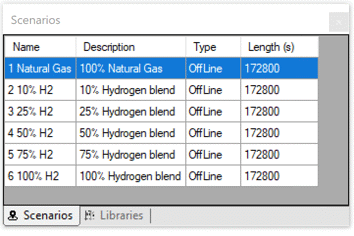Atmos SIM and hydrogen
Introduction
The transition from natural gas to hydrogen is at the forefront of what is happening in the global energy industry. The move to green hydrogen will, without doubt, be a large part of the solution to decarbonization and sustainable future energy.
To facilitate the transition from natural gas to hydrogen in the timescales required, the existing transportation infrastructure needs to be utilized wherever possible. As hydrogen blends increase, pipeline operators need to be fully aware of the capacity constraints the transportation of hydrogen generates. Using simulation tools is essential to ensure pipelines and networks are ready and emission targets are met.
This blog will explain how Atmos SIM is an excellent choice when looking for a tool to model hydrogen blends in pipeline systems.
Equations of state
Hydrogen/natural gas blends need to be accurately modelled from 0% to 100% hydrogen. Older equations of state, as found in many of the available simulation packages such as BWRS, are based on the critical properties of the individual components and do not include interaction coefficients for hydrogen.
Modern cubic equations like GERG-2004 are explicitly fit for the behaviour of mixtures, including hydrogen blends and would be a better choice. Fortunately, GERG-2004 is supported by Atmos SIM.
Pipe equations
The Colebrook-White friction factor is known to be accurate for hydrogen blends. The fluid doesn't impact the friction factor as long as there's either single-phase liquid or single-phase gas flow. Atmos SIM also supports the Colebrook-White pipe equation.
Sample calculations
This simple study looks at a single pipe of 10km in length controlled by pressure at the inlet and outlet. To ensure consistency between the simulations, an isothermal solution at 15.56 C was chosen. Each of the simulations was run twice, once using the BWRS EOS and once using GERG-2004. The simulation was run for the following cases
- Natural gas with 0% hydrogen
- Natural gas with 10% hydrogen
- Natural gas with 25% hydrogen
- Natural gas with 50% hydrogen
- Natural gas with 75% hydrogen
- Pure hydrogen
Results
The following results from both simulations are compared:
- Inlet density
- Flow
- Energy linepack
The results are shown in Table 1 below:

Table 1 Study results summary
It can be seen that for hydrogen blends, there can be a significant discrepancy between the two equations. At different pressure and temperature conditions, these differences could be greater still.
As a secondary check, a comparison of SIM density calculations using GERG-2004 for pure hydrogen was made with the NIST tables, known to be accurate to 0.1%.
https://webbook.nist.gov/cgi/fluid.cgi?ID=C1333740&Action=Page%20
The results of this comparison can be found in table 2 below:

Table 2 SIM compared to NIST
It is clear that the GERG-2004 EOS is very accurate.
Summary and additional observations
A modern cubic EOS like GERG-2004 as implemented in Atmos SIM is essential if hydrogen blend modelling is done to a high degree of accuracy.
Additionally, the ability to model multiple scenarios within a single configuration makes the configuration and running of models of varying hydrogen blends very quick and easy.

Figure 1 SIM Scenarios
